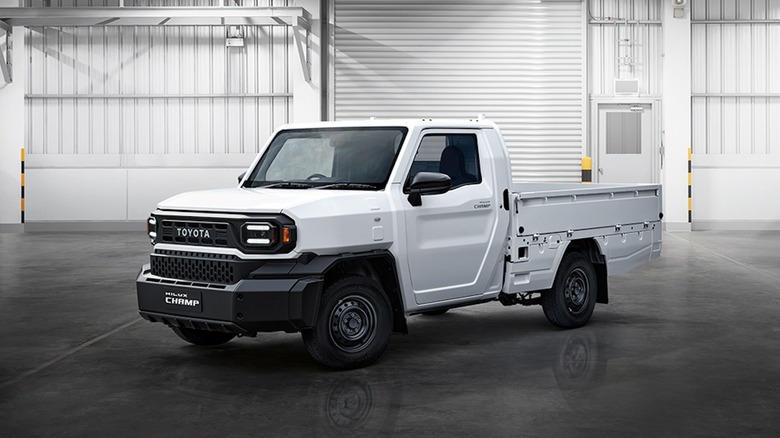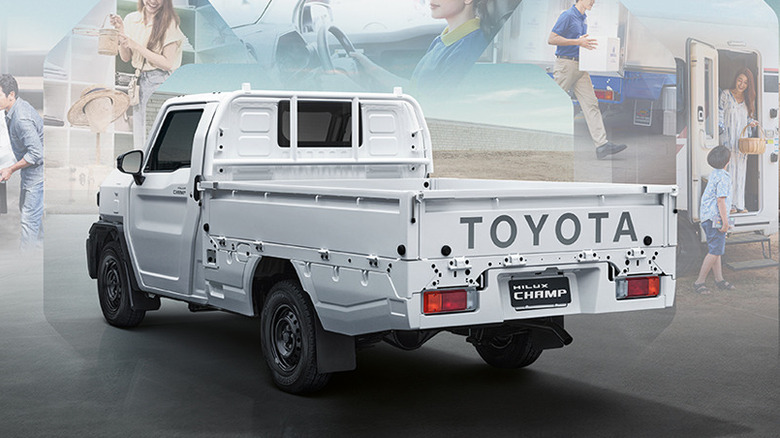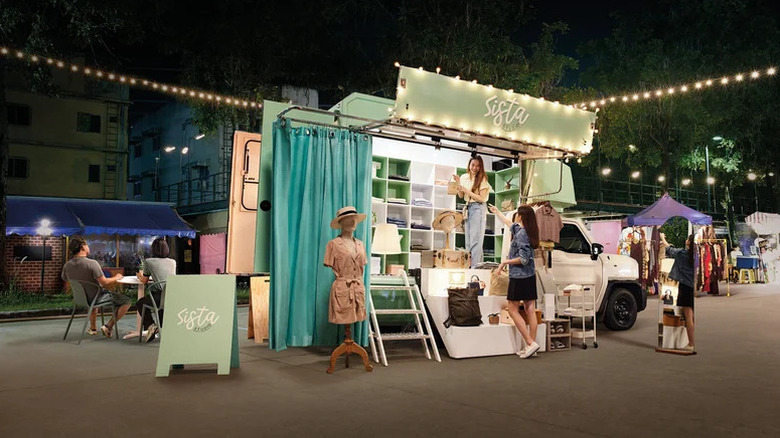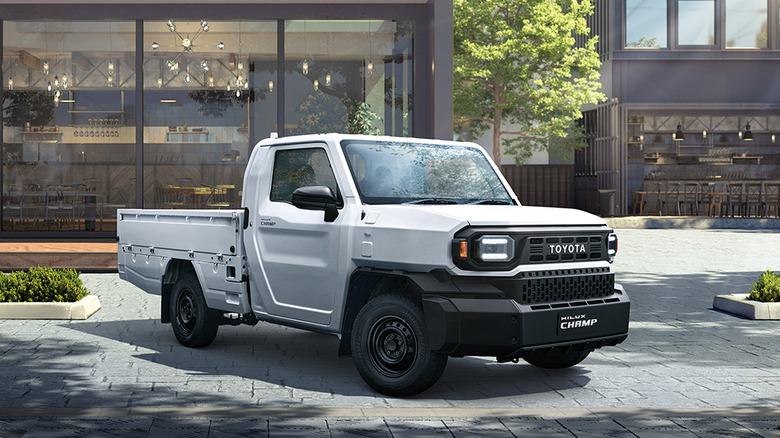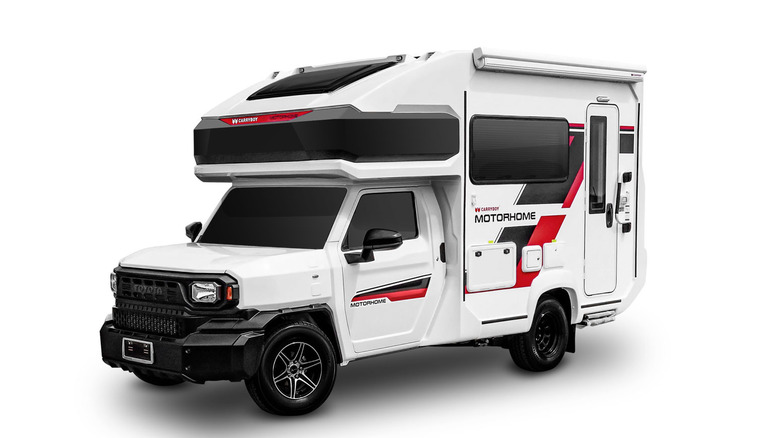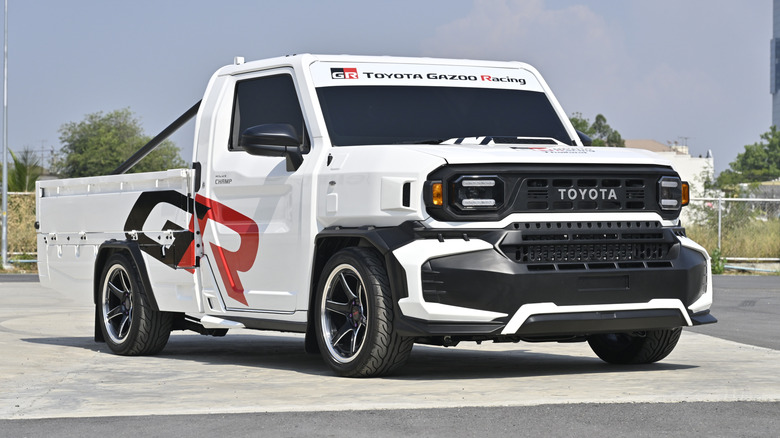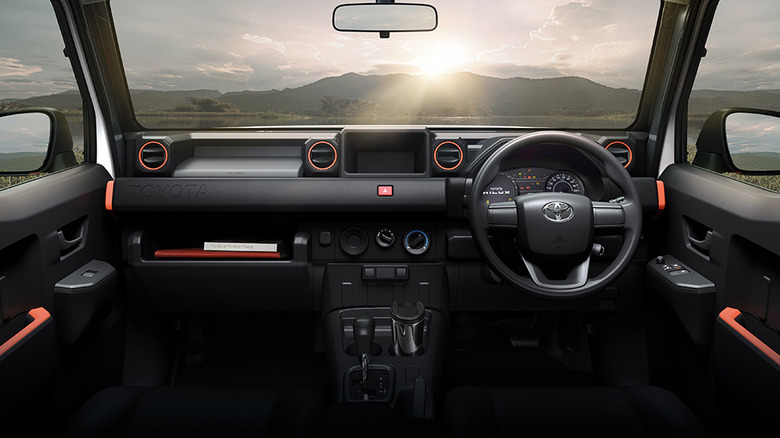Everything To Know About Toyota's $13,000 Pickup Truck
The Toyota IMV 0 concept truck was — like the "zero" in the name suggests — as basic as a vehicle gets. IMV stands for "Innovative International Multi-Purpose Vehicle," which means the first thing you'll need to know about this low-cost multipurpose pickup is that its production version will not be coming to the United States at any point in the future — putting it in the same league as some of our favorite trucks that aren't available in the U.S. This is a strictly international mode of transportation meant to slide under the segment of the least-expensive Hilux, a truck that some 180+ countries not named Canada or the U.S. can snatch up at a very appealing MSRP.
In fact, the IMV 0 shares the same platform name as the indestructible Hilux truck and was designed specifically for Toyota's customers in Thailand. As such, its production version launched with the name Hilux Champ in a country that is not only wild about its trucks, but also close enough to the carmaker's headquarters in Japan that it has evolved into a truck development incubator for other Southeast Asia markets.
Toyota decided to create the Hilux Champ as a cheaper option to the increasingly expensive Hilux, saying at the time of the Champ's introduction that it would be returning "to its origins" by releasing a small pickup that was "truly affordable" and yet still able to satisfy its customers' needs. Thus marked the arrival of a truck that is, at the time of writing, available brand new for $13,000.
This no-frills Champ is designed to last
When it debuted at the Japan Mobility Show in Tokyo in October 2023, estimates tabbed a starting MSRP of $10,000. However, during a launch event the following month in Bangkok, 11 customized models were introduced with a starting price that had increased to just over $13,000. As part of its back-to-basics approach, cost optimization was vital, but so was building a truck that real-world users could upgrade with after market add-ons based on their needs. At the time, Dr. Jurachart Jongusuk, the chief engineer for Toyota's Hilux-derived IMV platform, said the automaker aimed to deliver the vehicle "at 70 percent finished, with the remaining 30 percent customized by the customer."
Fast-forward and Toyota now offers the Hilux Champ in short and long-wheelbase versions, with the base configuration having rear-wheel drive. A gasoline 2.0-liter, inline-four engine is mated to a 5-speed manual transmission — with optional 2.7-liter gas or 2.4-liter diesel engines.
The Champ is bereft of virtually all "comfort" features, though that doesn't stop it from being one of the best-looking trucks Toyota has ever designed. At the base model, the windows are old-school crank, and plastic and rubber line the seats and floor. All the window glass has flat glazing. The deck comes without sides but can be upgraded. Some HVAC controls sit under a spot for a radio, and the instrument cluster is very basic. The base model may best be compared to the barest of bones rental moving van in the United States. However, options are available for nearly everything, which naturally increases the cost.
The Hilux Champ is highly customizable for different needs
Thailand's Champ is offered in several arrangements, including one with a flatbed sporting short hinged sides and another that comes with just the truck cab and no bed at all. The unequipped flat deck includes boltholes to let customers attach whatever they want to their Champ. Toyota Motor Thailand claimed at the time of introduction that it had more than 100 accessory manufacturers lined up to provide customers with an almost limitless number of customization options, including options for open-air retailers, food truck businesses, and even camping enthusiasts.
What about an electric version? Toyota's President Akio Toyoda addressed that at the 60th anniversary of its Thailand operations in December 2022. While the company is wholly committed to reducing emissions and achieving carbon neutrality goals, Toyoda doesn't think Battery Electric Vehicles (BEVs) are the only way to accomplish this. He added that everyone needs to be more realistic about how soon an actual global infrastructure can be created and supported.
Additionally, Toyoda said he'd "rather pursue every option, not just one — options such as emission-free synthetic fuels and hydrogen" because he feels hydrogen power is equally viable as BEVs. He backed this up by claiming he had recently driven a hydrogen-powered Toyota Yaris and was "blown away by its performance."
Why the Hilux Champ isn't available in the US or Canada
Following the trend of other Toyota trucks, the Hilux Champ is certainly cool. The best-selling truck in the United States, the Ford F-150, is available with dozens of different options, ranging from a well-equipped work truck, to an outright luxury vehicle. No matter the trim, the F-150 makes the Hilux Champ seem like a golf cart — and, as unfortunate as it is, the U.S. doesn't really have a market for stripped-down trucks.
On the safety end, the Hilux Champ doesn't match up to even a Toyota Corolla. The model only has two airbags and none of the driver assistance features that are standard on every Toyota sold in the United States. Additionally, importing a Thailand-market vehicle onto American roads means that Toyota would have to spend enormous amounts of money to emissions and safety test it. That undertaking just isn't worth the gamble if the truck doesn't sell well.
If that wasn't enough, trucks made overseas are subject to more import tariffs (something that's becoming increasingly relevant in recent months in 2025). Those tariffs, colloquially called the "Chicken Tax" would drive the price up significantly past the $13,000 market. At that point, it could eat into the market for the Tacoma and Toyota likely doesn't want its products competing with each other.
Hilux Champ camper conversions are available
When modified a bit, the Hilux is capable of having fun. A Thai company by the name of CarryBoy makes a slide-on camper attachment for the Champ. According to CarryBoy, the camper can sleep up to five, has a refrigerator, can be hooked up to hot water for showering, and it has an onboard toilet. It also has a retractable awning, a maximum 28,800-watt power station that can be charged by solar panels, and it can stand alone off the truck via electric jacks.
With all the tech and capability onboard, the price goes up fairly drastically. A full conversion from CarryBoy costs 1,997,000 Thai Baht, or around $61,000 for the base model. That's not a lot of cash compared to huge RVs that eclipse six-figure prices, but it's hardly an economical choice — the model is purely for people who want something a little wackier than your average campground options.
The Champ has proven itself on the racetrack
The Hilux Champ has also had a stint on the racetrack. Through Toyota Gazoo Racing Thailand, the Champ was modified to race in the Thailand Super Series. As such, the truck was fitted with a roll cage, race wheels, and a tuned drivetrain to be competitive. It was engineered in 2024 as part of Toyota Thailand and Toyota Gazoo Racing's efforts to make road cars/trucks into race cars. Toyota racing has fairly deep roots in Thailand, operating since 1986. As such, it makes sense for a Thailand-produced Toyota to hit the racetrack and burn some rubber.
During its first races in the 2024 racing season, the race-prepped Hilux Champ was competitive in a sea of Isuzus, placing in 11th place (out of 22) and averaging a speed of 133.83 kilometers per hour with Toyota Gazoo Racing Thailand's Songsak Kornsirisuepsakun at the wheel. The Hilux Champ didn't win, but it shows that Toyota is serious about making the truck a worthy competitor in the series. It plans to race the truck again in 2025.
There are downsides to owning a Champ
Hypothetically, if you were to import a Champ to the United States and live with it as a daily driver, it probably wouldn't be a fun experience (that is, unless you plan on using it strictly as a work truck). In its stock form, it's a vehicle for commercial use and as such creature comforts are almost nonexistent. Although the driver could go off-road if they wanted to, the Champ isn't an off-roader or overlander as it's currently only available in two-wheel drive — and given that its most powerful motor, the 2.7-liter gasoline-powered four cylinder, makes 166 horsepower, it's not a powerhouse by any stretch. It's about as utilitarian as you can get. Base models don't even have a radio.
A truck with almost no safety features, no interior features or comforts to speak of, and a small engine doesn't exactly translate to a pleasant driving experience, especially for a new car made in 2025.
